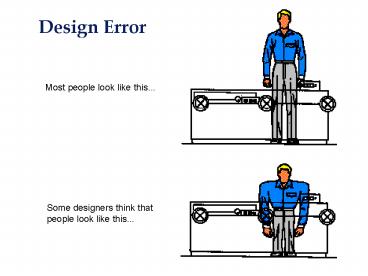Design Error - PowerPoint PPT Presentation
1 / 44
Title:
Design Error
Description:
Fitting the task to the man rather than forcing him/her to adapt to his working environment. ... Amputations 1% 1990 Ohio Injury/Illness Claims Information ... – PowerPoint PPT presentation
Number of Views:97
Avg rating:3.0/5.0
Title: Design Error
1
Design Error
Most people look like this...
Some designers think that people look like this...
2
What is Ergonomics?
- The study of man's relationship with his
workplace. - Fitting the task to the man rather than forcing
him/her to adapt to his working environment. - Designing the workplace to prevent occupational
injury and illness. - Discovering the capabilities and limitations of
the human body.
3
Balance for Optimization
Ergonomics
Worker Capabilities
Job Demands
4
CUMULATIVE TRAUMA DISORDERS (CTDs)
Ergonomics
Term assigned to identify a group of injuries
that classically result from long-term and
repeated wear and tear on the musculoskeletal
system.
- CUMULATIVE indicates injuries that develop
gradually over time, and result from many
repeated stresses on a particular body part. - TRAUMA signifies bodily insult or injury from
mechanical stresses. - DISORDERS describes the adverse health effects
that arise from chronic exposure to repeated
trauma.
5
Cumulative Trauma Disorders
Your Job
Trauma
Your Body
Healing Valve
6
Cumulative Trauma Disorders
Your Job
Trauma
Your Body
CTD
Healing Valve
7
Workplace Applications
Ergonomics
- Manual Materials Handling
- Cumulative Trauma Disorders (CTDs)
- Video Display Terminals (VDTs)
- Workplace/Workspace Design
- Control Display Design
- Adverse Environmental Conditions
8
Win - Win
Ergonomics
- Production
- Quality
- Compliance
- Compensation Costs
Healthy Workforce Careers/Employment Safety
Working Conditions
9
OSHAct 1970"General Duty Clause"
Ergonomics
DUTIES
Section 5. (a) Each employer -
(1) shall furnish to each of his
employees employment and a place of employment
which are free from recognized hazards that
are causing or are likely to cause death
or serious physical harm to his employees
10
Voluntary Guidelines
Ergonomics
o OSHA Meatpacking Guidelines o General
Industry Guidelines (dropped in lieu of
standard) o Food Distribution Warehouses o
ANSI HFS-100/1988 VDTs o ANSI Z-365 Control
of CTDs
11
Nature of Injury
Ergonomics
Burns 3
Contusions 9
Amputations 1
Occ Illness 4
Dislocations 2
F.B. in Eye 3
CTDs 5
Fractures 9
Laceration/Puncture 11
Strains/Sprains 43
1990 Ohio Injury/Illness Claims Information
12
Ergonomics
Part of Body
Arms 12
Hands 5
Trunk/Internal 11
Fingers 11
Back 20
Legs 13
Feet/Toes 5
Face/Neck 3
Mult/Major 13
Head 2
Other 15
Eyes 4
1990 Ohio Injury/Illness Claims Information
13
CTD Recognition Rising
Ergonomics
In 1990, 59 of all Occupational Illness Claims
are logged as CTDs
One half of all CTD claims are logged as Carpal
Tunnel Syndrome (CTS)
14
Ohio Back Injury Claims
Ergonomics
In 1990, 513 M was paid out by the BWC for back
injuries alone
15
Average Total Claim Cost
Ergonomics
Direct Costs Medical Comp Reserve
Indirect costs are estimated anywhere from 4 up
to 20 times direct costs
1980-1983 BWC data
(Thousands)
16
Iceberg AnalogyAccident Cost
Direct Costs
- Medical Payments
- Compensation
Down-time
Overhead while work disrupted
Breaking in substitute
Loss of production
Indirect or Hidden Costs
Efficiency due to break-up of crew
Loss of good will
Supervisor time to investigate
Damaged tools/equipment
Overtime to make up production
Failure to meet deadline/fill orders
Hiring costs
Lost time by fellow workers
17
Worksite AnalysisKey Elements
I. Records Analysis
18
Worksite Analysis
Records Analyses help identify prioritize jobs
to evaluate.
Accident Production Personnel Employer/Employee
Records Records Records Survey OSHA log
200 Seasonal Trends Turn-over Rate Symptoms
survey Incidence Rate Quality Control Absenteeism
Early reporting mechanism Prevalence Rate Model
Changes Suggestion award program First-aid
logs Bottlenecks Accident Invest. Workers Comp.
19
Worksite AnalysisKey Elements
I. Records Analysis
II. Risk Factor Recognition
20
OCCUPATIONAL RISK FACTORS
Attributes of a job or task that we know
increase the probability of developing a
musculoskeletal cumulative trauma disorder (CTD)
- FORCE (Internal External)
- POSTURE
- REPETITION
- INSUFFICIENT REST
Worksite Analysis
21
OCCUPATIONAL RISK FACTORS
Attributes of a job or task that we know
increase the probability of developing a
musculoskeletal cumulative trauma disorder (CTD)
- FORCE (Internal External)
- POSTURE
- REPETITION
- INSUFFICIENT REST
Worksite Analysis
22
Synovial Sheaths
Extensor Tendons
Carpal Ligament (Extensor Retinaculum)
23
(No Transcript)
24
TWO KINDS OF BACK INJURIES
MUSCULAR
SPINAL
25
Resting
Dynamic
Static
blood flow supplied
blood flow needed
blood flow supplied
blood flow needed
blood flow needed
blood flow supplied
26
Vertebrae
Top View
Side View
27
Micro-fractures in Vertebral Endplate
Scar tissue from healing fractures hinders
passage of nutrients to disc resulting in
gradual weakening and de-generation.
28
Disc Degeneration
29
Hierarchy of Controls
Ergonomics
Engineering Controls
FIRST CHOICE
Workstation Design Tool Design Process
Modification Mechanical Assist
Administrative Controls
Training Job Rotation Pacing Policy Job
Enlargement
Second Choice
Personal Protective Equipment
Gloves Wraps Shields
Last Least
30
BACK INJURIES
31
(No Transcript)
32
(No Transcript)
33
(No Transcript)
34
(No Transcript)
35
(No Transcript)
36
(No Transcript)
37
(No Transcript)
38
MAN VS. MACHINE
39
(No Transcript)
40
Horizontal Work Envelope
41
SIT OR STAND?
Type of Task Lifting more than 11lbs Work below
elbow height (e.g. packaging or
assembly) Extended horizontal reaching Light
assembly with repetitive movements Fine
manipulation and precision tasks visual
inspection and monitoring Frequent moving around
First Choice Standing Standing Standing Sitting S
itting Sitting Sit-Standing
Second Choice Sit-Standing Sit-Standing Sit-Stand
ing Sit-Standing Sit-Standing Sit-Standing Standin
g
42
(No Transcript)
43
(No Transcript)
44
(No Transcript)
45
Manual Tool Dimensions
A gt 4 B (for power grips) 1.5
C 3 to 3.5
(for precision operations) .45































